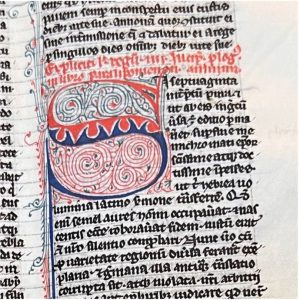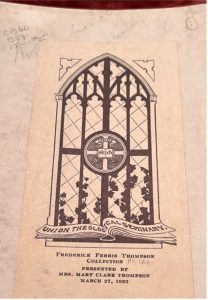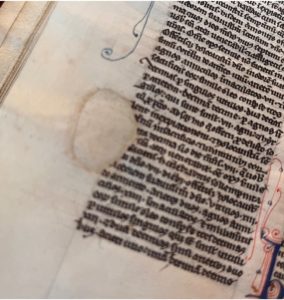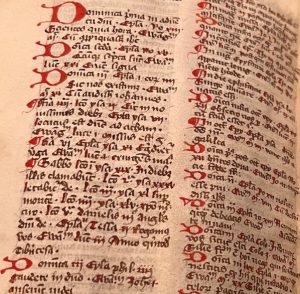The Burke Library’s resources include some wonderful examples of the first personal study Bible filled with innovations still in use today. These precious volumes are not from the 19th-century, the Reformation, nor even the first days of the printing press, but are manuscripts from the medieval world, products of the end of the period known as the twelfth-century renaissance.
These Bibles were produced in the thirteenth century by the many thousands in small, thick codices for handheld personal use, on 500-600 folia of impossibly thin and fine parchment (its crafting alone a lost art), with minute, precise writing and delicate embellishments. While the popular imagination usually pictures Western medieval manuscripts being produced in monastic scriptoria, these were actually made by both lay men and women working in the emerging commercial book trade, mostly in Paris and Oxford. A single Bible contained over 700,000 words and would take almost two years to complete; hand production on this scale is almost incomprehensible. As a genre, they have become known to many as “Paris Bibles.”
Last semester in Columbia’s Introduction to Medieval Manuscript Studies course, we had the opportunity to choose one of the manuscripts across the collection to examine in more detail. I chose MS 47, which has been at the Burke Library since March 27, 1923 – a century this month. During its long century in the library, it has been studied so little that it had nothing in its accompanying file – no provenance, no detail on its content, nothing beyond its scanty catalogue entry. I decided it had waited long enough for attention and deserved a celebration – and its own bibliographic file.

Paris Bibles are known not only for their size and relative uniformity in material features, but also for their revolutionary reference aides. In many ways, new elements pioneered in the Paris-type Bible of the 1240s have been preserved and handed down and are still visible in Christian study Bibles today: an historical order of the books, chapter divisions for quick reference, running titles in the top margin for easy navigation, and paratextual exegetical material tools for all-in-one reference. All medieval study tools!
Each book (or section of books) is preceded by a short preface introducing it and telling a little about who is thought to have written it, when, where, to whom, and why. Many of these are from Jerome; others are from medieval scholars.
Most, like MS 47, also include a highly-popular glossary, the Index of Hebrew Names, interpretatio hebraicorum nominum, which provided (imaginative, if not always accurate) exegetical fodder.
Nearly 2,000 Paris-type Bibles survive today in collections around the world, most of them in Europe. Here in New York City, there are just over two dozen in collections available to the public; Union actually has three: MSS 46, 47, and 48. For a North American institution, this is quite a special treasure. I made a number of fun discoveries about MS 47, including some about the way its early owners used it.

At first glance, MS 47 doesn’t have many marginal notes beyond small textual emendations, so it may strike the modern eye that it was never heavily used. However, a closer examination gives several signs to the contrary. There are dozens of tiny patches to the parchment, as well as other places with small holes (that are not related to ruling pinpricks). According to Alexis Hagadorn, Head of Conservation for the Columbia University Libraries, these most likely held tiny silk thread markers for quick reference. The patches fixed spots where use of the markers eventually tore the parchment.

Another indicator of heavy study use are the dozens of whimsical manicula (hands with a finger pointing at the text) drawn by early users to function as medieval highlighters. These appear in several different inks and sizes throughout the volume; one even has a very long arm to encapsulate a large bit of text! If you go looking, they are quite concentrated in the Wisdom books and the book of Romans.

Finally, I discovered that one of its first users was a Dominican, as an early hand supplied a Dominican lectionary on the blank folia at the end of the quire containing the book of Revelation.

Although I’d set out just to analyze and document its features, along the way I was able to amass enough evidence to strongly suggest that its origin is French, rather than the catalogue’s former “English?” designation. One of the many identifying features includes aspects of its beautiful pen scrollwork. While most Paris-type Bibles are not illuminated (using gold leaf), and only some have notable figural artistic decoration, nearly all have blue-and-red penwork and beautiful painted initials.

It’s my suspicion that because they lack stunning golden pages and are “just Bibles” that these treasures have gone largely ignored by many modern scholars. But what a pity – there’s so much to consider! Let’s look at just a few more interesting aspects to MS 47.
Check out the opening to the Gospel of Luke. The small initial is the Prologue, and the larger one is the beginning of the book:

Quoniam quidem multi conati sunt ordinare narrationes quae in nobis complete sunt rerum sicut tradiderunt nobis qui ab initio ipsi viderunt et ministri fuerunt sermonis: visum est et mihi assecuto omnia a principio diligenter ex ordine tibi scribere optime Theophile ut cognoscas eorum verborum de quibus eruditus es veritatem.
Fuit in diebus Herodis regis Judee sacerdos quidam nomine Zacharias de vice Abya et uxor illius de filiabus Aaron et nomen eius Elisabeth.
“But wait,” you say, “doesn’t Luke start with ‘Quoniam’ and not ‘Fuit’?” Well, yes it does. Isn’t it fascinating that there was a time that was considered a preamble and not part of the Gospel? There are several other books where the opening (and closing!) are not clear – not just in MS 47, but across the Paris Bible tradition, with multiple variants flourishing well into the era of printed text, even beyond the Reformation and the Council of Trent. (Some variants may be traced to recensions circulating in Late Antiquity; others are due to scribal error and the proliferation of exemplars.)
MS 47 has several other wonderful secrets – some of which I hope to present in future work, and some which I hope you’ll come and discover for yourself. (Extra chapters and verses! Hebrew and Greek words! Cool other bits!)
The middle ages aren’t past – we hold much of the twelfth and thirteenth-century in our hands every time we pick up a modern Bible. Spending time with these incredible manuscripts honors the work of all the women and men who worked to pass it on to us today, and helps modern Bible scholars like me realize that today’s questions about the Bible aren’t really all that new.
Come join me!
Loraine Enlow (she/her) is a second-year doctoral student in the Bible Department at the Jewish Theological Seminary studying the exegetical entanglements between Jews and Christians in 12th-and 13th-century England and France. She works as Music Associate at St. James’ Church, Madison Avenue (Episcopal). When she’s not fangirling over manuscripts, she can usually be found running in Central Park, knitting, or playing the bassoon.
Great efforts share, thanks for sharing such type of information. The Burke Library’s resources include some wonderful examples of the first personal study Bible filled with innovations still in use today.
This is really interesting; you’re a very skilled blogger. I’ve joined your rss feed and look forward to seeking more of your excellent post.
Every time i visit your blog it amazes me again and again… Very nice article. Thank you.
I love to suggest simply great moreover successful advice, that is why start to see the merchandise:
RR88 nhanh chóng thu hút sự quan tâm của rất nhiều hội viên khi mang đến hình thức tham gia game cực kỳ hiện đại
ga88.cafe mang đến không gian giải trí chất lượng, hấp dẫn, đáng để trải nghiệm.
789WinMe.com có cộng đồng người chơi đông vui, giao lưu cực kỳ thú vị!
Tốc độ nạp và rút tiền trên bet88wl.com cực kỳ nhanh chóng, tôi luôn nhận tiền về ngay lập tức!
XIBET là link chuẩn vào nhà cái XIBET trải nghiệm thả ga với đầy đủ các sản phẩm gồm: lô đề, xổ số, đá gà, casino, thể thao,…và nhiều loại hình khác.
Nhà cái Goal123 là link chuẩn vào nhà cái XIBET trải nghiệm thả ga với đầy đủ các sản phẩm gồm: lô đề, xổ số, đá gà, casino, thể thao,…và nhiều loại hình khác.
Khuyến mãi Qibe là nền tảng game hàng đầu, mang đến trải nghiệm cá cược đẳng cấp với các sản phẩm như đổi thưởng thể thao, đào vàng trực tuyến, slot game, bắn cá, …
vb777.studio không có hỗ trợ cho thiết bị di động
Tốc độ tải trang của five88.tube nhanh và ổn định
F168 không chỉ đảm bảo tính minh bạch và công bằng trong mỗi phiên cược mà còn cung cấp cho người chơi các trò chơi hấp dẫn và đa dạng
ga67.cam cập nhật trận đấu nhanh chóng và đầy đủ
one2betgaming.com khuyến mãi hấp dẫn, thưởng lớn
vnae2bet.games live casino chân thực, dealer chuyên nghiệp
davidsons.uk.com không cung cấp thông tin về giấy phép hoạt động
gunbet.com là địa chỉ cá cược uy tín đáng để trải nghiệm
teamprisoners.com không có ưu đãi hay khuyến mãi
RR88 là game trực tuyến uy tín, cung cấp đa dạng sản phẩm chơi có thưởng tiền như thể thao, bắn cá, slot game và xổ số. Với nền tảng hợp pháp, hệ thống bảo mật …
Tốc độ tải trang fun88.rip nhanh và ổn định
sao789t.com là lựa chọn hàng đầu của tôi khi muốn giải trí trực tuyến
Giao diện của tg88app.net thiết kế hiện đại và dễ sử dụng
t789f.com không có cộng đồng người chơi đông đảo để tương tác
khin789.gg thường xuyên gặp lỗi khi đăng nhập hoặc truy cập tài khoản
ta88u.com cung cấp dịch vụ cá cược trực tuyến uy tín và an toàn
Ga888.com dễ gây cảm giác spam hoặc giả mạo
ga888.games luôn giữ sự ổn định trong mọi khung giờ
x.com/w88npcom cập nhật thường xuyên các chương trình khuyến mãi hấp dẫn
czech-ladies.eu.com làm tôi cảm thấy mình được tôn trọng
8live.ad mang lại trải nghiệm người dùng rất tốt
zowin.black cho phép đăng ký tài khoản nhanh và dễ dàng
Nạp và rút tiền ở đây cực nhanh, 23WIN biết cách làm mọi thứ tiện lợi.
7CLUB có tỷ lệ trả thưởng cao, mang lại cơ hội thắng lớn cho người chơi
vn99ok.net là nơi giải trí uy tín mà mình giới thiệu cho bạn bè
vnbong88.me giao diện mobile tối ưu rất tốt khi chơi trên điện thoại
nhacaiuytin-vietnam.com giúp mình hiểu rõ hơn về kèo giao bóng trước
gluckint.in.net không mang lại giá trị thông tin thực tế
sunwin20.today dễ dàng truy cập trên cả máy tính và điện thoại di động
tg88co.com chơi ổn định không lo bị giật lag
Xibet – Xibet De Nha Cai Ca Cuoc Uy Tin Top 1 Chau A
ww888.vin là nhà cái uy tín mình gắn bó lâu dài
fossils.uk.com trải nghiệm mua sắm không mượt mà
gamebai.in.net hỗ trợ nhiều hình thức thanh toán tiện lợi
az8888.org bảo mật thông tin cá nhân cực kỳ tốt
dagatructiep.com.co đội ngũ quản trị hoạt động rất hiệu quả
socolive0.com chất lượng hình ảnh sắc nét chuẩn full HD
i9betz1.com cập nhật game liên tục, không gây nhàm chán
vu88 là đơn vị tổ chức game trực tuyến uy tín, cung cấp đa dạng sản phẩm xổ số. Với nền tảng hợp pháp, hệ thống bảo mật …
j88z.io giao diện hiện đại, dễ sử dụng trên cả điện thoại và máy tính
vn999.cam cộng đồng người chơi đông vui, hỗ trợ và chia sẻ rất tích cực
k9bett.io cập nhật trò chơi thường xuyên, không gây nhàm chán
23wineandwhiskey.co.uk có giấy phép rõ ràng, hoạt động minh bạch và hợp pháp
bmwbet.us bảo mật tốt, người chơi hoàn toàn yên tâm khi tham gia
goal1234.net chơi giải trí vui vẻ và có thể kiếm thêm thu nhập ổn định
gavangtv.com.mx liên tục cập nhật game mới giúp người chơi luôn thấy thú vị
fizika.in hỗ trợ nhiều phương thức nạp rút tiền tiện lợi
sinbet.ink hỗ trợ nhiều kênh thanh toán nhanh chóng và tiện lợi
saobet.shop phù hợp với cả người mới chơi và dân cược lâu năm
daga.deal cập nhật trò chơi mới liên tục, mang lại trải nghiệm tươi mới
superenduro.uk.com liên kết nội bộ kém, nhiều link bị lỗi
xoso66.trading có bảng xổ số dễ nhìn, phân loại rõ ràng từng đài
bl555s.com cập nhật kèo thể thao liên tục, tỷ lệ minh bạch và chính xác
blogideashk.com tổ chức sự kiện và minigame hấp dẫn, dễ chơi dễ trúng
cakhiatv.lifestyle cộng đồng người chơi đông đảo, chia sẻ kinh nghiệm rất hữu ích
nhacaijun88.dev tỷ lệ cược cao, chơi vài ván là dễ có lợi nhuận rõ rệt
123B là đơn vị tổ chức game trực tuyến uy tín, cung cấp đa dạng sản phẩm xổ số. Với nền tảng hợp pháp, hệ thống bảo mật …
acb88.ltd có app riêng tiện lợi cho điện thoại
relativelyoffbeat.com đọc trên điện thoại rất mượt và tiện lợi
hay88.pics hệ thống hoạt động ổn định không giật lag
u88.press thông tin rõ ràng, minh bạch dễ hiểu
cakhiatv-tv.com chăm sóc khách hàng 24/7, rất tận tâm và chu đáo
gamebaidoithuong10.click game bài đa dạng, không bị nhàm chán
abc8.gg app chơi mượt mà, tương thích tốt với cả iOS và Android
Link vào mn88 là đơn vị tổ chức game trực tuyến uy tín, cung cấp đa dạng sản phẩm xổ số. Với nền tảng hợp pháp, hệ thống bảo mật …
88XX là đơn vị tổ chức game trực tuyến uy tín, cung cấp đa dạng sản phẩm xổ số. Với nền tảng hợp pháp, hệ thống bảo mật …
23win là đơn vị tổ chức game trực tuyến uy tín, cung cấp đa dạng sản phẩm xổ số. Với nền tảng hợp pháp, hệ thống bảo mật …